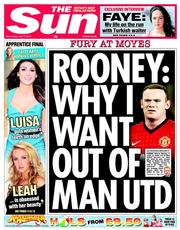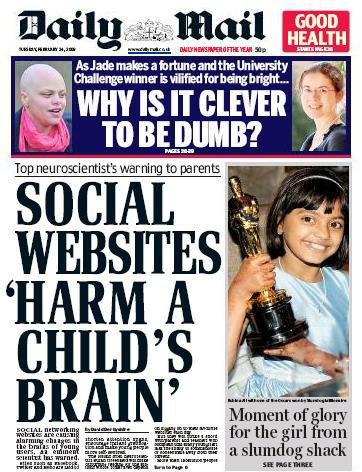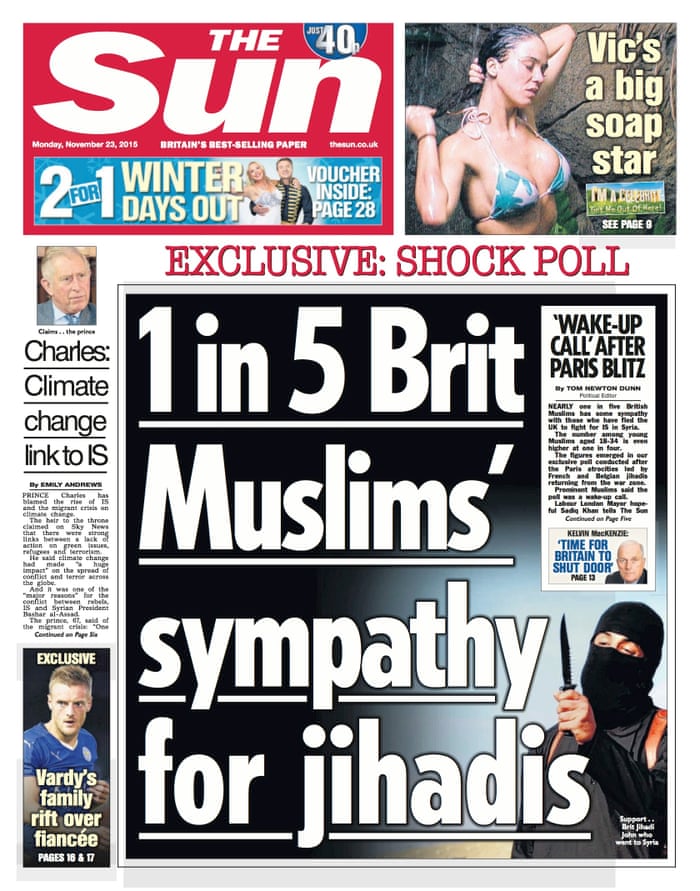Friday, November 23, 2018
Friday, November 16, 2018
Comparing front covers


The Sun:
The front cover/main story for this tabloid newspaper is about a famous professional footballer called Wayne Rooney. This story includes the news values of an elite person and also the story is unambiguous. By using a famous person on the front cover, it appeals to the younger generation, particularly if they are into football.
The intended audience for this newspaper are younger adults/ people of the ages between about 30 and 40. This is because the newspaper includes a large sized sport section as a main story and also there is celebrity news and gossip along the side of the newspaper. Therefore, the older generations may not want to read this because of all of the younger celebs included.
This is quite a negative article because the facial expressions on most of the celebs featured look sad or moody and so this automatically creates a feeling of negativity.
The Guardian:
The front cover/main story for this broadsheet newspaper is about the death of two young children. This story includes the news values of threshold as it is a hard-hitting story which really can affect some people who have experienced the same thing, unexpectedness as it is an abnormal story, negativity as it is not a happy story, personalisation because it includes 'real' people who are involved in the story and finally, proximity because it is quite close to home as it is about a family situation. This broadsheet contains a lot more news values than a tabloid does.
The intended audience for this newspaper is more likely to be people who have a family of their own/older generations. This is because the story is mainly about young children so people who would be affected most by this would be parents who have young children. Also, this newspaper is very informative as there is a larger ratio of text to images rather than a tabloid where there is more pictures.
This is also a fairly negative story. One of the children in the main image has a facial expression of sadness however the other one looks fairly happy as he is smiling. Therefore, you can tell by the negative tone of the headline that this is a negative article.

Above is an example of a mid market tabloid. The Daily Mail is a fairly popular newspaper which is neither a tabloid nor a broadsheet.
The front cover/main story of this newspaper is about social websites affecting the brains of children. This story includes the news values of this story is threshold, negativity, proximity and continuity. Continuity is a value in this article as social websites are always being talked about as negative/detrimental for children or anyone.
This is a negative article as it talks about the harming of children and their body parts. By having this as a front cover it makes the audience feel like they want to know the rest of the story and how it has become the front page of a newspaper.
Tuesday, November 13, 2018
Online newspapers
Advantages of online newspapers:
> environmentally friendly
> easier to update (live updates)
> larger audience
> more modern
> easy access for some
> don't have to go out to a shop (more practical)
> free (paywalls - Daily Telegraph, The Times)
> your own personal account to choose topics - personalising it
> contact papers quickly
> comments on news stories - audience participation
> easy to share articles
> more interactive - video
Disadvantages of online newspapers:
> holding something - more liked by people
> internet needed
> can't keep the story
> less accessible for the older generations
> more information in the paper
> pop-ups
> long term eye strain
> technical errors
> environmentally friendly
> easier to update (live updates)
> larger audience
> more modern
> easy access for some
> don't have to go out to a shop (more practical)
> free (paywalls - Daily Telegraph, The Times)
> your own personal account to choose topics - personalising it
> contact papers quickly
> comments on news stories - audience participation
> easy to share articles
> more interactive - video
Disadvantages of online newspapers:
> holding something - more liked by people
> internet needed
> can't keep the story
> less accessible for the older generations
> more information in the paper
> pop-ups
> long term eye strain
> technical errors
Monday, November 12, 2018
News values
> Threshold - the bigger the impact and reach of the story
> Unexpectedness - an event that is a shock or out of the ordinary
> Negativity - bad news is more interesting 'if it bleeds, it leads'
> Elite persons/places - stories about important people and powerful nations
> Unambiguous - stories that are easy to understand and for papers to report on
> Personalisation - stories that include human interest - 'real' people
> Proximity - stories that are closer to home that are more likely to be included
> Continuity/currency - stories that are already in the news continue to run and are updated
C U P P T U N E = ACRONYM
> Unexpectedness - an event that is a shock or out of the ordinary
> Negativity - bad news is more interesting 'if it bleeds, it leads'
> Elite persons/places - stories about important people and powerful nations
> Unambiguous - stories that are easy to understand and for papers to report on
> Personalisation - stories that include human interest - 'real' people
> Proximity - stories that are closer to home that are more likely to be included
> Continuity/currency - stories that are already in the news continue to run and are updated
C U P P T U N E = ACRONYM
GUARDIAN and DAILY MIRROR comparison
|
QUESTIONS
|
THE GUARDIAN
|
THE DAILY MIRROR
|
|
Who was involved?
|
Bidhya Sagar Das, the mother who is not named, a witness and twins (1
boy and 1 girl).
|
Bidhya Sagar Das, Gui Gui (witness), baby boy Gabriel, baby girl
Maria and Cristinela Das.
|
|
What happened?
|
Bidhya killed the one-year-old boy with a hammer and his sister was critically
injured.
Child dies and his sister is critically injured. Investigators await
results of post-mortem exam.
|
A man has been held over a suspected hammer attack on twin toddlers
that killed one and left the other fighting for life.
|
|
Where did it happen?
|
Finsbury Park, North London.
|
Property in Hackney, North London.
|
|
When did it happen?
|
Saturday 18th March 2017, late on the Saturday. The police
were called at 11:10 pm
|
Saturday 18th March 2017. At 11:10 pm that night, the mum
ran into the streets screaming.
|
|
Why did it happen?
|
|
|
|
What do you notice about the difference in content and how the
articles convey this information? Why do you think that is?
|
The article does not go into a lot of depth about why and how the
incident happened. There is more information on the witnesses and the later
events that weekend. The article also does not include the names of the
twins. There is much more text in this article.
|
There are larger images in this article to make it stand out how
children are involved. By using a large image of children, it automatically
creates an emotional aspect of the article and the story. Witness quotes are
used in the article. Article is more emotional and less informative.
|
Tuesday, November 6, 2018
Monday, November 5, 2018
Assessment Reflection
HERE ARE THE QUESTIONS AND ALSO THE MARKSCHEME FOR THE ASSESSMENT:

LANGUAGE
With
reference to the TV drama poster, answer questions 1-3
Q1: How is media language used to create meaning?
With reference to Media Language
– Camera, Mise En Scene, Denotation, Connotation, Layout, Colour, Text
Q2. Who is the target audience and how do you know?
Q3. What are the various readings and interpretations of the advert?
(40)
GENRE
Q4:
What is genre? How does the theorist Steve Neale define genre? What codes and conventions are used to
identify genre?
Give examples of media texts to support your answer.
(25)
INDUSTRY
Q5. With reference to the industry you have researched and presented:
·
How far do you agree with Curran and Seaton's ideas that media
concentration generally limits or inhibits variety, creativity
and quality?
·
How have advances in technology
affected the distribution and consumption of the media products?
·
How is the media industry you have
studied regulated and are there any areas which you think may be hard to
enforce?
(35)
MARK SCHEME
Questions 1-3 Media
Language (40)
(Comprehensive 28-40,
Adequate 18-27, Minimal 1-17, 0 No response or no response worthy of credit)
·
Comprehensive, detailed and accurate application
of knowledge and understanding of
Media language to analyse source A.
·
Explaining how the media language fits these
conventions, mise en scene to include layout, typography
·
Convincing, perceptive and accurate analysis of
representations in Source A, which consistently provides logical connections
and a good line of reasoning.
·
Reference to Source is detailed and accurate.
·
Target audience defined by main character,
themes, title of programme, genre, channel 4, Sunday night at 9pm (school
night). Sponsored by Lexus.
Question 4 Genre (25)
(Comprehensive 17-25,
Adequate 10-16, Minimal 1-9, 0 No response or no response worthy of credit)
·
Precise and relevant reference to Steve Neale’s
genre theory – repetition and difference / hybrid
·
Comprehensive, detailed and accurate application
of knowledge and understanding with media examples of codes and convention of
genre (ie. DISTINCT)
Question 5 Industry
(35)
(Comprehensive 22-35,
Adequate 11-21, Minimal 1-10, 0 No response or no response worthy of credit)
·
A comprehensive response to the set question.
·
A comprehensive and accurate knowledge and
understanding of the industry studied
·
Answer is supported by detailed and accurate
reference to Curran and Seaton.
·
Clear and precise and balanced explanation of
the impact of digitally convergent media platforms on production, distribution
and consumption
Cameras, editing techniques, special effects,
marketing tricks online, clever campaigns that go viral, cinemas 3D, super
screen, IMAX, 4D, screen X for film for eg
Podcasts, social media, interactive
websites, comments etc
·
Answer is supported by generally accurate
reference to the regulation of industry studied.
ASSESSMENT
1A - GBHS MEDIA STUDIES A LEVEL Marksheet
Name: Regan
Boyle Date: 29/10/2018
Mark:
62
AO1: Demonstrate knowledge and
understanding of the theoretical framework of media and contexts of media and
their influence
AO2 Apply knowledge and understanding of
the theoretical framework of media to:
Analyse media products/Evaluate
academic theories/ Make judgements and draw conclusions
Level
3
57+
A/B
|
·
A comprehensive response to the set question
·
Comprehensive and
accurate knowledge and understanding
·
Convincing, perceptive and accurate analysis
·
Convincing, perceptive and accurate evaluation
·
Highly developed and accomplished judgements
and conclusions
The
response demonstrates a highly developed and detailed line of reasoning which
is coherent and logically structured. The information presented is entirely
relevant and substantiated.
|
Level
2
40-56
C/D
|
·
An adequate response to the set question
·
Adequate and generally accurate knowledge and understanding
·
Adequate and generally successful analysis
·
Adequate and
generally successful evaluation
·
Adequate and
generally well-reasoned judgements and conclusions
The
response demonstrates a line of reasoning with some structure. The
information presented is in the most part relevant and supported by some
evidence.
|
Level
1
Up
to 40
D/U
|
·
A minimal response to the set question
·
Minimal application of knowledge and understanding
·
Analysis is minimal
and/or largely descriptive and may not be relevant
·
Evaluation is
minimal or brief, and is likely to be largely descriptive
·
Judgements and
conclusions, if present, are minimal with limited support
·
Information
presented is basic and may be ambiguous or unstructured. The information is
supported by limited evidence.
|
Identify a strength or strengths in
your assessment:
I did well when answering the whole
section on media language because out of the possible 40 marks on those 3
questions, I got 36. Therefore, I only lost 4 marks on this section. I think
that this is because a lot more time was spent on media language and I found
it more interesting to learn (especially as it was the first thing large
topic that I learnt when being introduced to A – Level Media).
What are the areas you need to improve?
I need to improve my knowledge on the
theorists because I knew that Steve Neale was to do with genre but I didn’t remember
anything else about him.
What do you need to focus on for your
next assessment?
I need to focus more on the theorists and
also the industry as they were my weaker aspects of the assessment.
|
Friday, November 2, 2018
Representation
Dominant ideology:
> Ruled by middle class, white male, straight, Christian
> Stereotypical
Stereotypes:
> Media industries use stereotypes because the audience will instantly understand them
> Think of stereotypes as a 'visual shortcut'
> They're repeated so often that we assume that they are normal or even true
Archetypes:
> This is the 'ultimate' stereotype
> For example: the white, stiletto wearing, big busted, brainless, blonde bimbo
Countertypes:
> A representation that challenges traditional stereotypes associations of groups or people
Representation:
> The way in which people, events and ideas are presented to the audience
> So, the media takes something that's already there and represents it to us in a way that they chose
> These representations are created by the producers of media texts
> Ruled by middle class, white male, straight, Christian
> Stereotypical
Stereotypes:
> Media industries use stereotypes because the audience will instantly understand them
> Think of stereotypes as a 'visual shortcut'
> They're repeated so often that we assume that they are normal or even true
Archetypes:
> This is the 'ultimate' stereotype
> For example: the white, stiletto wearing, big busted, brainless, blonde bimbo
Countertypes:
> A representation that challenges traditional stereotypes associations of groups or people
Representation:
> The way in which people, events and ideas are presented to the audience
> So, the media takes something that's already there and represents it to us in a way that they chose
> These representations are created by the producers of media texts
Stuart Hall
He was looking into mass media and also the power of how media can represent DRCAGES. DRCAGES stands for:
D - disability
R - regional identity
C - class
A - age
G - gender
E - ethnicity
S - sexuality
Oppositional, negotiated and preferred readings.
Examples of these influences in media:
Statement: "This drink is the best drink in the world, you'll love it!"
Oppositional: "No, I definitely won't love this drink at all!"
Negotiated: "This drink might be one of the best drinks in the world!"
Preferred reading: "This drink is definitely the best drink in the world!"
Preferred reading is what producers want you to believe.
Subscribe to:
Comments (Atom)
Jean Baudrillard - Post Modernism theory + application of usefulness
Baudrillard's theory: - The idea that in postmodern culture, the boundaries between the 'real' world and the world of the medi...

-
Paul Gilroy's theory: - The idea that colonial discourses continue to inform contemporary attitudes to race and ethnicity in the postc...
-
Baudrillard's theory: - The idea that in postmodern culture, the boundaries between the 'real' world and the world of the medi...
-
How are different social groups represented in the sequence you have analysed? What role does the use of media language, signs and signifie...




